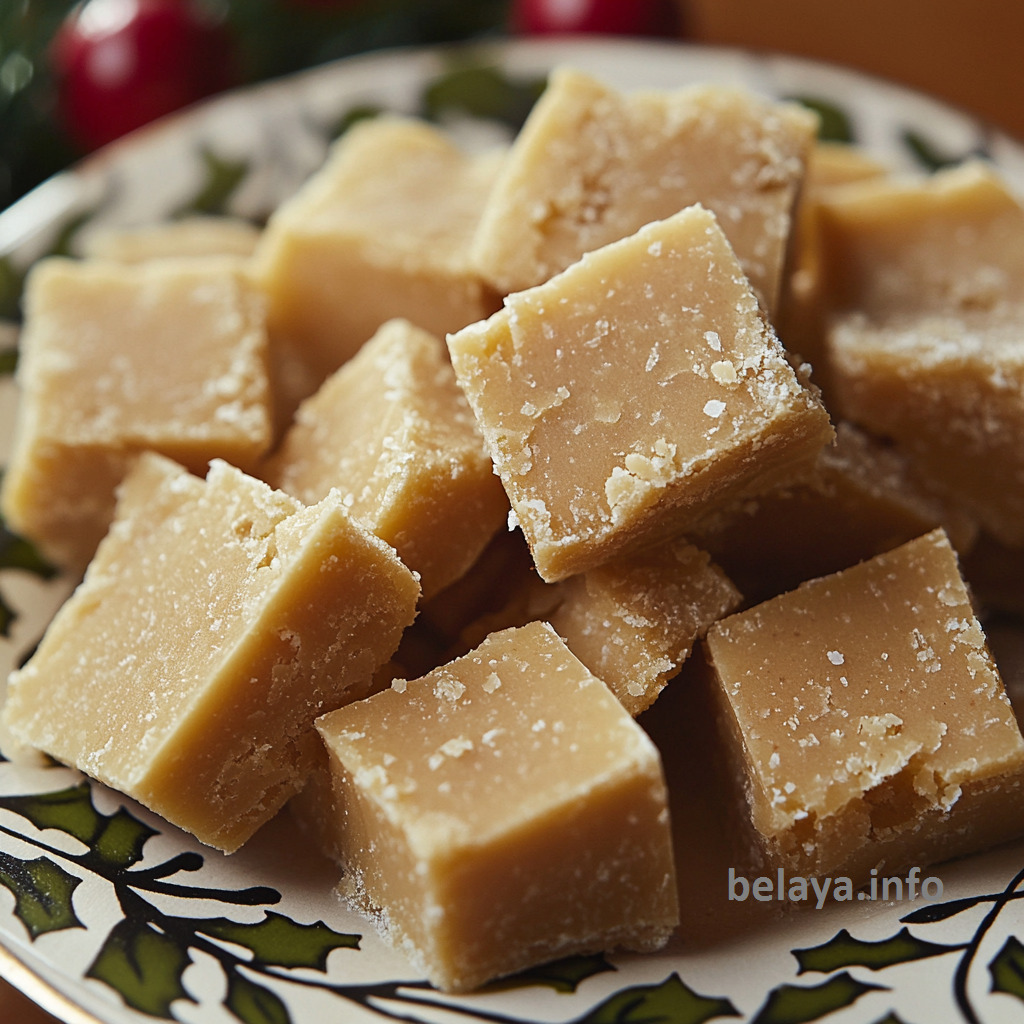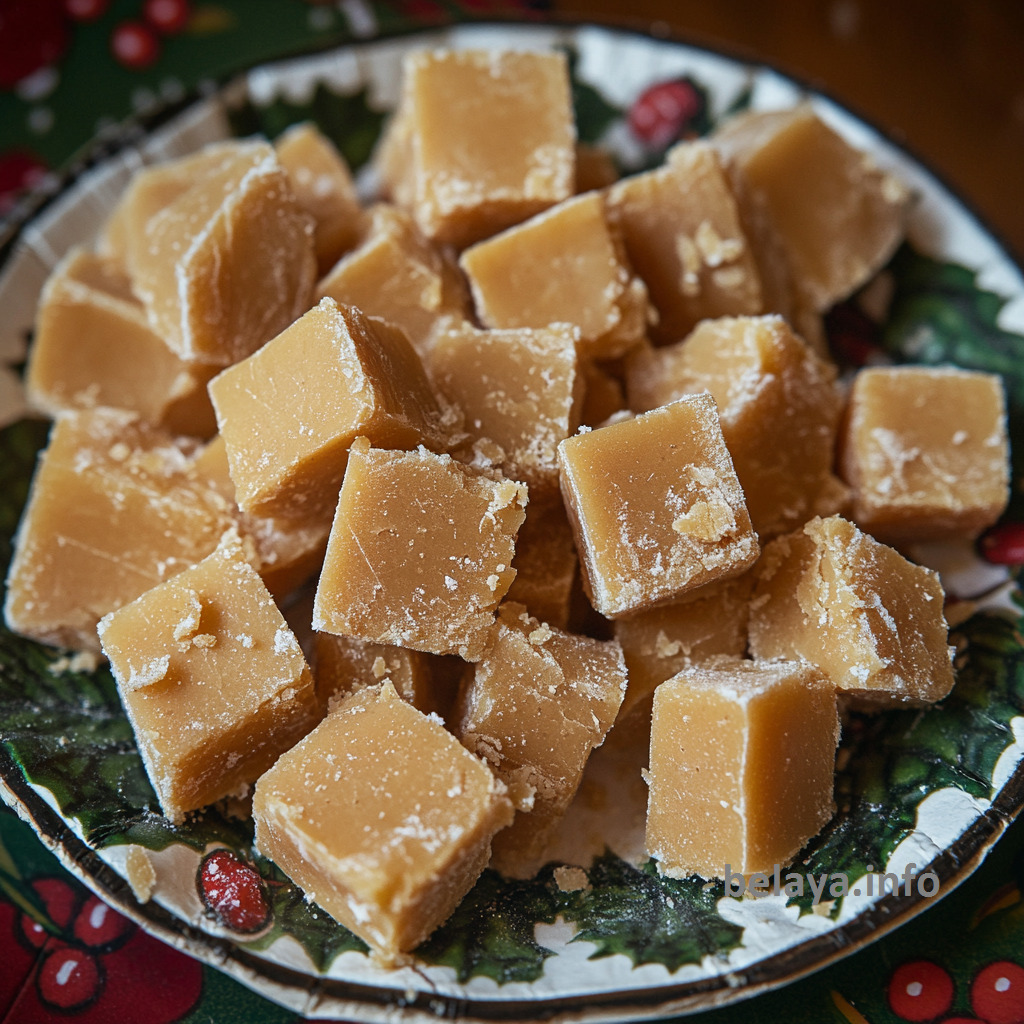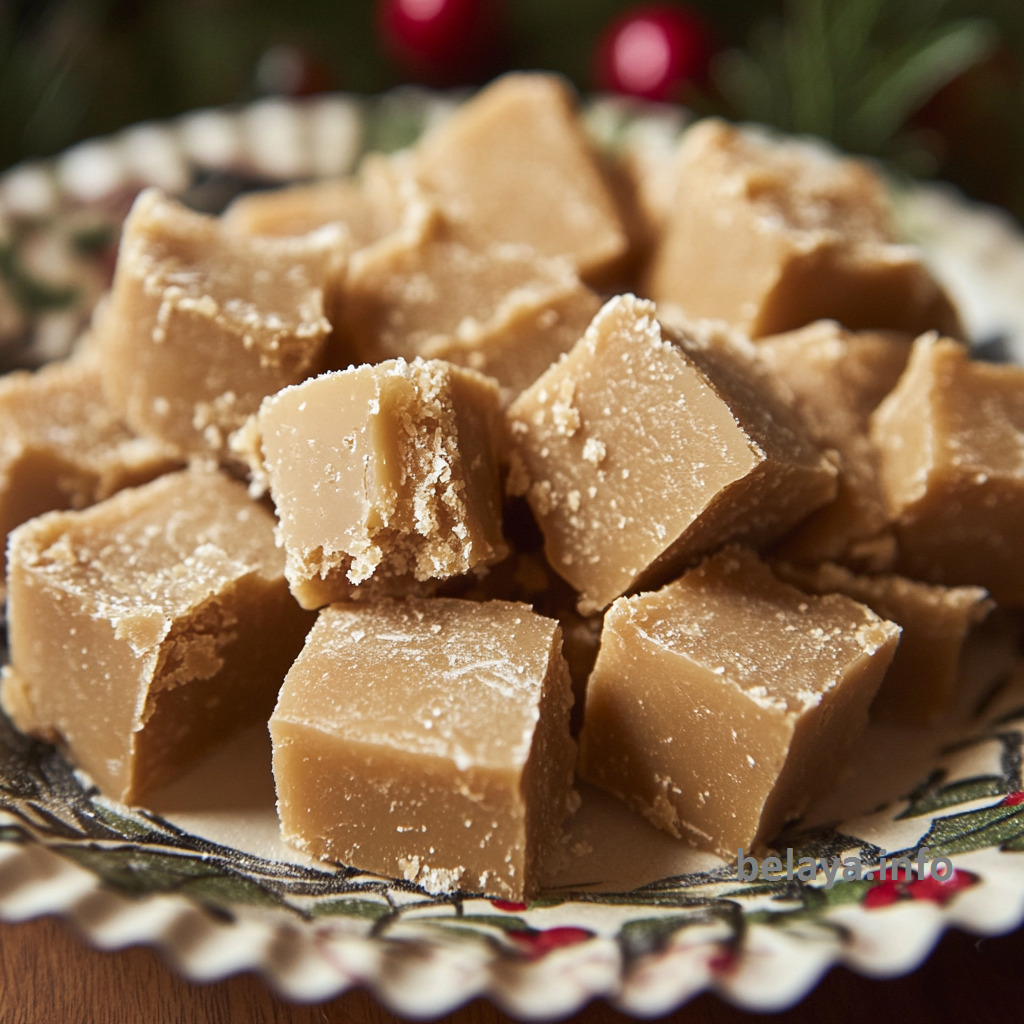Scottish Tablet
Scottish Tablet is more than just a sweet—it’s a beloved cultural treasure rooted in generations of tradition. With its melt-in-your-mouth texture and rich caramelized flavor, this confection is a nostalgic taste of Scotland’s culinary heritage.
Unlike fudge, tablet has a crumbly, grainy consistency that comes from slow simmering and vigorous beating—transforming just a few humble ingredients into something truly special. Often gifted during holidays or shared at celebrations, this classic treat carries with it a sense of warmth, home, and history in every bite.
Whether flavored with vanilla or deepened with a splash of whisky, Scottish Tablet remains a timeless indulgence worth mastering.

Why People Will Love The Scottish Tablet Recipe:
Rich nostalgic value: This traditional Scottish sweet connects people to cultural roots and family heritage, evoking warm memories of holidays, gatherings, and homemade gifts.
Simple ingredients, luxurious taste: With just four pantry staples—sugar, milk, butter, and condensed milk—this recipe transforms the ordinary into an indulgent, melt-in-your-mouth experience.
Unique texture: Unlike fudge, tablet has a distinctive grainy, crumbly consistency that offers a satisfying contrast to its creamy sweetness—delivering a sensory delight with every bite.
Perfect for sharing: Its firm yet sliceable nature makes it ideal for gifting, sharing at events, or packaging as a homemade treat that feels both thoughtful and special.
Customizable flavor: A splash of vanilla or whisky allows home cooks to tailor the flavor to their liking, adding personal flair while keeping the soul of the recipe intact.
Rewarding craftsmanship: The process of boiling, beating, and setting gives a sense of accomplishment, making it as enjoyable to create as it is to enjoy.

Key Ingredients:
Granulated sugar forms the foundation of the tablet, providing structure, sweetness, and the signature crystalline texture that distinguishes it from smoother confections like fudge.
Whole milk introduces creaminess and depth, allowing the sugar to caramelize gently and contribute to the rich, toffee-like flavor of the finished candy.
Sweetened condensed milk adds concentrated sweetness and body, ensuring the mixture thickens to the proper consistency while enriching the tablet with a luscious creaminess.
Salted butter rounds out the flavor, balancing the intense sweetness with a hint of savory richness and contributing to the smooth mouthfeel and golden color.

Expert Tips:
Use a heavy-bottomed, deep pan: Tablet boils rapidly and can easily scorch if the pan is too thin. A heavy saucepan ensures even heat distribution and reduces the risk of burning the sugar and milk.
Watch the temperature closely: The ideal temperature range is 240–248°F (soft-ball stage). Going too far beyond this can cause the tablet to harden too much, while undercooking may lead to a runny or chewy consistency.
Stir frequently but not constantly: Stir often enough to prevent scorching—especially once the condensed milk is added—but avoid over-stirring early on, as this can lead to crystallization too soon.
Beat at the right time: Once removed from heat, allow the mixture to cool slightly before beating—about 5–7 minutes. This allows the sugar to begin setting and gives the tablet its classic crumbly texture.
Beating is critical: Don’t skip or skimp on the beating process. It changes the texture from glossy and soft to firm and matte. Use a hand mixer for speed, or a sturdy wooden spoon for the traditional approach, beating until the mixture thickens and trails begin to form.
Score before fully set: After pouring into the pan, let it cool for about 10 minutes, then lightly score the surface with a knife. This makes it easier to cut later without crumbling the entire slab.
Humidity matters: Avoid making tablet on humid days if possible. High moisture in the air can interfere with sugar crystallization and lead to a sticky, soft result.

Scottish Tablet
Ingredients:
4 1/2 cups granulated white sugar
1 cup whole milk
1 (14 oz) can sweetened condensed milk
6 tablespoons salted butter
Instructions:
Prepare the Pan:
Lightly grease a 9×13-inch baking pan and line it with parchment paper.
Use a smaller pan if you prefer thicker pieces.
Melt Initial Ingredients:
In a large, microwave-safe bowl, combine the sugar, milk, and butter.
Heat in 30-second bursts, stirring between each, until the butter is melted and the sugar begins to dissolve.
Cook the Mixture:
Transfer the mixture to a large, deep saucepan or stockpot.
Set the heat to medium-high and bring to a boil, stirring occasionally.
Once boiling, reduce the heat to medium and stir in the sweetened condensed milk.
Be careful — the mixture will expand rapidly.
Simmer and Thicken:
Lower the heat and let the mixture bubble gently for 15–20 minutes, stirring frequently to prevent sticking or burning.
Cook until it thickens and takes on a rich caramel color.
The temperature should reach between 240°F and 248°F.
If you don’t have a thermometer, drop a small amount into cold water — if it forms a soft ball, it’s ready.
Optional Flavoring:
Remove from heat and stir in 1 teaspoon of vanilla extract or 1 tablespoon of whiskey for added flavor, if desired.
Beat the Mixture:
Using a hand mixer or a sturdy wooden spoon, beat the mixture for 8–10 minutes until it thickens and starts to lose its shine.
Stop when you can see trails left by the mixer or spoon.
Set the Tablet:
Pour the mixture into your prepared pan, smoothing it out by gently tapping the pan on the counter.
Avoid touching the surface with your spoon.
After about 10 minutes, lightly score the top with a knife to make cutting easier later.
Cool and Slice:
Let the tablet cool and set completely for 2–4 hours (or overnight).
Once firm, cut along the score lines into pieces.

Important Notes When Making Scottish Tablet:
Texture is everything: Unlike fudge, tablet is meant to have a slightly grainy, crystalline texture. Don’t expect a silky finish—its charm lies in its crumbly bite and melt-in-your-mouth consistency, which comes from controlled crystallization during the beating process.
Timing is critical: Each stage—from boiling, to simmering, to beating—requires attention. Undercooking may lead to soft, chewy tablet, while overcooking or overbeating can result in a dry, brittle product.
Don’t rush the set: Patience is key. The tablet needs several hours at room temperature to firm up completely. Rushing the cooling or refrigerating it too soon can affect the texture and moisture balance.
Choose your pan wisely: The thickness of your final tablet depends on the size of your pan. A 9×13-inch pan yields thinner pieces, while an 8×8-inch pan produces thick, chunkier squares. Line with parchment for easy removal.
Flavor additions are optional but impactful: A teaspoon of vanilla extract or a tablespoon of Scotch whisky added after cooking can elevate the flavor. But these should be added off the heat to preserve their delicate notes.
Store correctly: Once cut, tablet should be stored in an airtight container at room temperature. It keeps well for up to two weeks and even improves in texture after the first day.
Mastery comes with repetition: Tablet is a traditional recipe passed down through generations, and it may take a few attempts to master. Don’t be discouraged by inconsistencies—each batch brings new insight.

How To Enjoy Scottish Tablet After Cooking
Let It Cool Completely
Patience is key with tablet. Allow it to set fully at room temperature for at least 2–4 hours (or overnight if possible). Rushing the cooling process can result in a grainy or uneven texture. The perfect tablet should be firm but not brittle, with a slight crumble when bitten into.
Cut with Care
Once the tablet is fully set, cut it along the score lines using a sharp, heavy knife. Clean the blade between cuts for clean, sharp edges. Cutting too early or too roughly may cause crumbling or uneven chunks.
Serve in Small Pieces
Tablet is incredibly rich and sweet, so it’s best served in small, bite-sized squares. One or two pieces per person is often enough to satisfy, making it ideal for sharing.
Pair Thoughtfully
Enjoy tablet with:
- A strong cup of black tea or espresso to cut through the sweetness
- A glass of whisky or liqueur for a traditional Scottish pairing
- A mild cheese board, using tablet as a sweet contrast
It’s also a lovely companion to dessert platters, holiday tins, or festive gift boxes.
Store Properly
Keep tablet in an airtight container at room temperature for up to 2 weeks. Avoid refrigerating, as it can affect the texture and cause the sugar to crystallize unevenly. For gifting, wrap individual pieces in wax paper or parchment for a rustic, handmade touch.
Gift and Share
Scottish Tablet is a traditional gift during holidays, weddings, and celebrations. Package it in cellophane bags or tins, add a ribbon, and share a piece of Scotland’s sweetest tradition with friends and family.
Nutrition Information
Based on a batch cut into approximately 60 small pieces (standard size for rich confections like this):
Calories: 130 kcal | Total Fat: 4.8 g | Saturated Fat: 3.0 g | Monounsaturated Fat: 1.3 g | Polyunsaturated Fat: 0.2 g | Cholesterol: 15 mg | Sodium: 45 mg | Total Carbohydrates: 23.5 g | Dietary Fiber: 0 g | Sugars: 23.0 g | Protein: 0.8 g

Frequently Asked Questions
What’s the difference between Scottish tablet and fudge?
Scottish tablet is firmer and more crumbly than fudge, with a distinctive grainy texture.
While both are sugar-based confections, fudge is creamy and smooth, whereas tablet has a melt-in-the-mouth texture achieved by controlled crystallization and extended beating.
Why did my tablet turn out too soft or too hard?
This usually comes down to temperature control.
If it’s too soft, it likely didn’t reach the soft-ball stage (240–248°F).
If it’s too hard or brittle, it may have been overcooked.
Using a candy thermometer or the cold water test is essential for consistent results.
Can I make Scottish tablet without a thermometer?
Yes, but you’ll need to use the cold water method: drop a small bit of the mixture into a glass of cold water.
If it forms a soft, malleable ball, it’s ready to remove from heat.
A thermometer, however, makes this process more precise and foolproof.
How long does Scottish tablet keep, and how should I store it?
Once fully set and cut, store tablet in an airtight container at room temperature.
It keeps well for up to 2 weeks, and the texture often improves after a day or two as it dries slightly.
Avoid refrigerating, as it can make the texture uneven.
Can I add other flavors or ingredients to this recipe?
Yes! Traditional tablet is plain or made with vanilla, but many people enjoy adding a tablespoon of Scotch whisky, almond extract, or even finely chopped nuts for variation.
Add these after removing the pan from the heat to preserve flavor.
Why is it important to use a deep, heavy-bottomed pan when making tablet?
Tablet boils rapidly and can easily bubble over or scorch.
A deep, heavy-bottomed pan distributes heat evenly and prevents burning, while giving enough space for the mixture to expand safely as it boils.
How do I know when to stop beating the mixture?
Stop beating when the mixture thickens, loses its glossy sheen, and begins to hold its shape—your spoon or mixer should leave visible trails.
Overbeating can make it set too fast; underbeating can leave it too soft or sticky.
What happens if I don’t beat the tablet after cooking?
Skipping the beating stage will result in a chewy or greasy texture rather than the signature crumbly finish.
Beating encourages sugar crystallization, which is essential to achieve the correct texture.
Why is my tablet grainy in a bad way or unevenly set?
Improper temperature control or premature stirring can cause large, uneven sugar crystals.
Make sure the sugar is fully dissolved before boiling, and avoid stirring too aggressively at the start.
Also, beat only after removing it from heat.
Can I double the recipe or reduce it?
You can adjust the quantity, but keep in mind that larger batches require longer boiling and beating times.
The risk of scorching also increases, so monitor the temperature carefully and adjust your pan size accordingly.